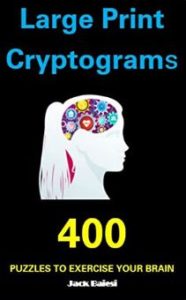
A cryptogram is a type of puzzle that consists of a short piece of encrypted text.
There are different types of cryptograms. The most popular is the letter-to-letter substitution. In this method, the text is encrypted by replacing each letter with a different letter to create a sentence that seems incomprehensible before it is solved.
A puzzle that would use this code would look like this:
WQBPM AGXK ZPPU
With these substitutions:
W=E, Q=N, B=J, P=O, M=Y, A=T, G=H, X=I ,K=S ,Z=B, P=O, U=K
It becomes:
ENJOY THIS BOOK
The ciphers used in cryptograms were not created for entertainment purposes, but for encryption of military or personal secrets.
The first use of the cryptogram for entertainment purposes occurred during the Middle Ages by monks who had spare time for intellectual games.
Around the thirteenth century, the English monk Roger Bacon wrote a book in which he listed seven cipher methods, and stated that “a man is crazy who writes a secret in any other way than one which will conceal it from the vulgar.”
In the 19th century, Edgar Allan Poe helped to popularize cryptograms with many newspaper and magazine articles. [en.wikipedia.org/wiki/Cryptogram]
This book contains a collection of 400 quotes encrypted with a simple substitution cipher. The quotes are from:
Writers
Philosophers
Scientists
Mathematicians
Poets
Politicians
Actresses
World Leaders
Authors
Musicians
Enjoy yourself while solving the puzzles, don’t feel bad if you can’t figure one out right away.
If you need some help, a hint for each puzzle can be found on a page at the end of each group. After the hints, the puzzle answers are reported.
Solving engaging puzzles like cryptograms exercises the brain, helping it to remain sharp.
